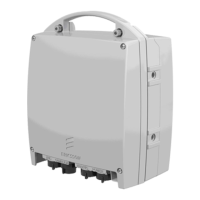MINI-LINK BAS 5-6
Technical Description EN/LZB 111 0542 P2B
5.2.1.1 Amplitude Control Loop
Amplitude control is necessary in down or uplink direction in order to
have a constant signal at the input of the demodulator passing from a
TDMA slot to the adjacent one. In fact in the uplink direction there are
the contributions of the different terminals served by the RN.
Therefore for proper operation the received power level from each
terminal shall be equalised. This is accomplished by the amplitude
control loop: in the RN the amplitude is measured and an error signal
is send back to the terminal in order to adjust output power until error
is within a proper threshold.
The RAU in the node transmits at a fixed output power level whereas
the RAUs of terminals change dynamically their output power in such
a way that the signal at the input of the modem in the node holds
nominally equal amplitude from all the ATs.
In order to control carrier amplitude a facility is provided to measure
the amplitude of the received signal referred to Received Signal
Strength Indication (RSSI).
The information concerning the error relevant to the amplitude is
evaluated in the node modem exploiting also the RSSI information
coming from radio.
The transmitted power is fine-tunable in the terminal radio only. The
RN sends, via Internal Radio Control Channel (IRCC) interface, the
peak value of the received signal to the modem, where this value is
compared with a reference amplitude, to guarantee the required signal
to noise ratio for each AT in uplink direction. The result of the
comparison is a byte, which represents the amplitude error.
5.2.1.2 Frequency Control Loop
The carrier frequency of all terminals in uplink direction must be
controlled too, in order to be compliant with the frequency stability
requirements.
In the RAU, both the transmitter and the receiver are locked to the
same reference frequency, this is generated from an internal reference
supplied by a Voltage Controlled Temperature Compensated Crystal
Oscillator (VCTCXO).
Synchronisation of carrier frequency of terminals is accomplished
using the Node carrier frequency as a reference. The RN carrier
frequency is locked to a fixed IF reference inside the NCU.
In the ATs the nominal reference frequency is the carrier frequency
from the RN; the frequency lock is performed in the NU, calculating
the carrier residue with respect to the RN-NCU main reference
frequency, in the Rx direction.

